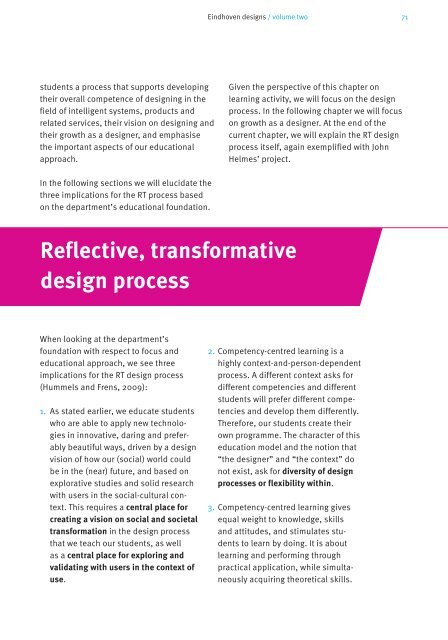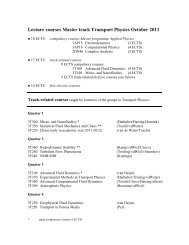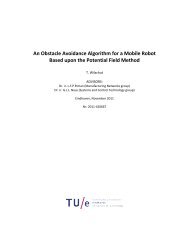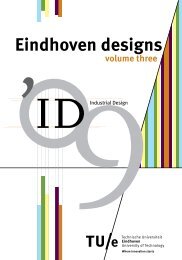Education guide 'Eindhoven designs' - Technische Universiteit ...
Education guide 'Eindhoven designs' - Technische Universiteit ...
Education guide 'Eindhoven designs' - Technische Universiteit ...
You also want an ePaper? Increase the reach of your titles
YUMPU automatically turns print PDFs into web optimized ePapers that Google loves.
Eindhoven designs / volume two 71<br />
students a process that supports developing<br />
their overall competence of designing in the<br />
field of intelligent systems, products and<br />
related services, their vision on designing and<br />
their growth as a designer, and emphasise<br />
the important aspects of our educational<br />
approach.<br />
Given the perspective of this chapter on<br />
learning activity, we will focus on the design<br />
process. In the following chapter we will focus<br />
on growth as a designer. At the end of the<br />
current chapter, we will explain the RT design<br />
process itself, again exemplified with John<br />
Helmes’ project.<br />
In the following sections we will elucidate the<br />
three implications for the RT process based<br />
on the department’s educational foundation.<br />
Reflective, transformative<br />
design process<br />
When looking at the department’s<br />
foundation with respect to focus and<br />
educational approach, we see three<br />
implications for the RT design process<br />
(Hummels and Frens, 2009):<br />
1. As stated earlier, we educate students<br />
who are able to apply new technologies<br />
in innovative, daring and preferably<br />
beautiful ways, driven by a design<br />
vision of how our (social) world could<br />
be in the (near) future, and based on<br />
explorative studies and solid research<br />
with users in the social-cultural context.<br />
This requires a central place for<br />
creating a vision on social and societal<br />
transformation in the design process<br />
that we teach our students, as well<br />
as a central place for exploring and<br />
validating with users in the context of<br />
use.<br />
2. Competency-centred learning is a<br />
highly context-and-person-dependent<br />
process. A different context asks for<br />
different competencies and different<br />
students will prefer different competencies<br />
and develop them differently.<br />
Therefore, our students create their<br />
own programme. The character of this<br />
education model and the notion that<br />
“the designer” and “the context” do<br />
not exist, ask for diversity of design<br />
processes or flexibility within.<br />
3. Competency-centred learning gives<br />
equal weight to knowledge, skills<br />
and attitudes, and stimulates students<br />
to learn by doing. It is about<br />
learning and performing through<br />
practical application, while simultaneously<br />
acquiring theoretical skills.

















